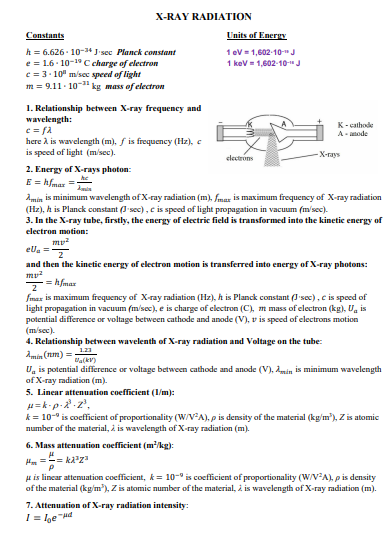
College Physics
11th Edition
ISBN: 9781305952300
Author: Raymond A. Serway, Chris Vuille
Publisher: Cengage Learning
expand_more
expand_more
format_list_bulleted
Question
The 10-fold X-ray reduction values for (a) water, (b) concreate, (c) iron and (d) lead are equal 100 cm, 20 cm, 10 cm and 5 cm, respectively. Find corresponding values of linear attenuation coefficients.

Transcribed Image Text:X-RAY RADIATION
Constants
Units of Energy
h = 6.626 - 10-3“ J•sec Planck constant
e = 1.6- 10-19 C charge of electron
e = 3- 10" m/sec speed of light
m = 9.11. 10- kg mass of electron
1 ev = 1,602-10-" J
1 kev = 1,602-10-"J
1. Relationship between X-ray frequency and
wavelength:
K-cathode
A- anode
here A is wavelength (m), f is frequency (Hz), e
is speed of light (m/sec).
Х-гауs
clectrons
2. Energy of X-rays photon:
E = hfmaz =
Amin is minimum wavelength of X-ray radiation (m), fmar is maximum frequency of X-ray radiation
(Hz), h is Planck constant (I sec), c is speed of light propagation in vacuum (m'sec).
3. In the X-ray tube, firstly, the energy of electric field is transformed into the kinetic energy of
electron motion:
my?
ela =
and then the kinetic energy of electron motion is transferred into energy of X-ray photons:
- = hfmar
fmax is maximum frequency of X-ray radiation (Hz), h is Planck constant I sec), c is speed of
light propagation in vacuum (m/sec), e is charge of electron (C), m mass of electron (kg), U, is
potential difference or voltage between cathode and anode (V), v is speed of clectrons motion
(m/sec).
4. Relationship between wavelenth of X-ray radintion and Voltage on the tube:
1.23
Amin (nm) =
Da(kv)
U, is potential difference or voltage between cathode and anode (V), 2min is minimum wavelength
of X-ray radiation (m).
5. Linear attenuation coefficient (I/m):
H= k-p-2.2',
k = 10-° is coefficient of proportionality (W/VA), p is density of the material (kg/m'), Z is atomic
number of the material, i is wavelength of X-ray radiation (m).
6. Mass attenuation coefficient (m'kg):
H. =-= kza
H is linear attemuation coefficient, k= 10-° is coefficient of proportionality (W/V-A), p is density
of the material (kg/m), Z is atomic number of the material, i is wavelength of X-ray radiation (m).
7. Attenuation of X-ray radiation intensity:
I = lbe "Hd

Transcribed Image Text:here I, is the initial intensity of X-rays (W/m); / is the intensity of X-rays after passing a material of
(1/m)
8. Half value layer.
HVL =-
In(2) 0,693
u is lincar attenuation coefficient (1/m).
Expert Solution
This question has been solved!
Explore an expertly crafted, step-by-step solution for a thorough understanding of key concepts.
This is a popular solution
Trending nowThis is a popular solution!
Step by stepSolved in 6 steps with 6 images

Knowledge Booster
Learn more about
Need a deep-dive on the concept behind this application? Look no further. Learn more about this topic, physics and related others by exploring similar questions and additional content below.Similar questions
- from 7/2 to TI from (–10) to (10) (2a) The average of f(x) = cos(3x) (2b) The average of f(x) = x² (2c) The average of f(x) = 2x sin(x) (2d) The average of f(x) = 3x from 0 to ↑ %3D from (-3) to (3)arrow_forwardIf density of mercury is 13600 kg/ m = 9.8 m/s?. Find the energy of translation 3 and g %3D per cubic metre of oxygen at N.T.P.arrow_forwardRose bengal is a chromophore used in biological staining that has an absorption maximum at 559.1 nm and several other shorter wavelength absorption bands in the ultraviolet and visible regions of the spectrum when dissolved in ethanol. What is the energy difference, in kilojoules per mole, between the absorption maximum at 559.1 nm and a band at 221.5 nm? E = kJ/molarrow_forward
- If A =〖yz〗^2 i-3xz^2j +2xyz k, B = 3xi +4zj -xyk and ∅= xyz, findd^2/dxdy [Ax (B.∅)] at P(1, 1, 1)arrow_forwardThe observed fluorescence lifetime in the absence of a quencher is 1.4 ns. In the presence of a quencher the fluorescence lifetime is 0.8 ns. Calculate the quenching efficiency. which is the ratio of the f luorescence quantum yieldsin the presence and absence of the quencher. φF/φF,0.arrow_forward
arrow_back_ios
arrow_forward_ios
Recommended textbooks for you
 College PhysicsPhysicsISBN:9781305952300Author:Raymond A. Serway, Chris VuillePublisher:Cengage Learning
College PhysicsPhysicsISBN:9781305952300Author:Raymond A. Serway, Chris VuillePublisher:Cengage Learning University Physics (14th Edition)PhysicsISBN:9780133969290Author:Hugh D. Young, Roger A. FreedmanPublisher:PEARSON
University Physics (14th Edition)PhysicsISBN:9780133969290Author:Hugh D. Young, Roger A. FreedmanPublisher:PEARSON Introduction To Quantum MechanicsPhysicsISBN:9781107189638Author:Griffiths, David J., Schroeter, Darrell F.Publisher:Cambridge University Press
Introduction To Quantum MechanicsPhysicsISBN:9781107189638Author:Griffiths, David J., Schroeter, Darrell F.Publisher:Cambridge University Press Physics for Scientists and EngineersPhysicsISBN:9781337553278Author:Raymond A. Serway, John W. JewettPublisher:Cengage Learning
Physics for Scientists and EngineersPhysicsISBN:9781337553278Author:Raymond A. Serway, John W. JewettPublisher:Cengage Learning Lecture- Tutorials for Introductory AstronomyPhysicsISBN:9780321820464Author:Edward E. Prather, Tim P. Slater, Jeff P. Adams, Gina BrissendenPublisher:Addison-Wesley
Lecture- Tutorials for Introductory AstronomyPhysicsISBN:9780321820464Author:Edward E. Prather, Tim P. Slater, Jeff P. Adams, Gina BrissendenPublisher:Addison-Wesley College Physics: A Strategic Approach (4th Editio...PhysicsISBN:9780134609034Author:Randall D. Knight (Professor Emeritus), Brian Jones, Stuart FieldPublisher:PEARSON
College Physics: A Strategic Approach (4th Editio...PhysicsISBN:9780134609034Author:Randall D. Knight (Professor Emeritus), Brian Jones, Stuart FieldPublisher:PEARSON

College Physics
Physics
ISBN:9781305952300
Author:Raymond A. Serway, Chris Vuille
Publisher:Cengage Learning

University Physics (14th Edition)
Physics
ISBN:9780133969290
Author:Hugh D. Young, Roger A. Freedman
Publisher:PEARSON

Introduction To Quantum Mechanics
Physics
ISBN:9781107189638
Author:Griffiths, David J., Schroeter, Darrell F.
Publisher:Cambridge University Press

Physics for Scientists and Engineers
Physics
ISBN:9781337553278
Author:Raymond A. Serway, John W. Jewett
Publisher:Cengage Learning

Lecture- Tutorials for Introductory Astronomy
Physics
ISBN:9780321820464
Author:Edward E. Prather, Tim P. Slater, Jeff P. Adams, Gina Brissenden
Publisher:Addison-Wesley

College Physics: A Strategic Approach (4th Editio...
Physics
ISBN:9780134609034
Author:Randall D. Knight (Professor Emeritus), Brian Jones, Stuart Field
Publisher:PEARSON